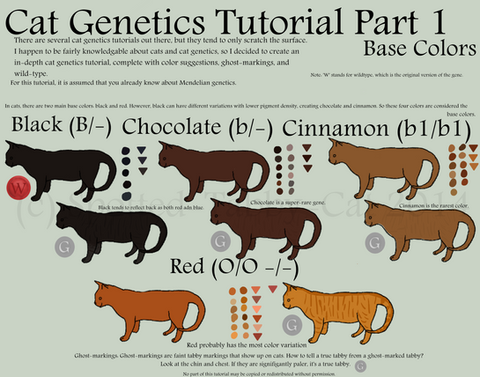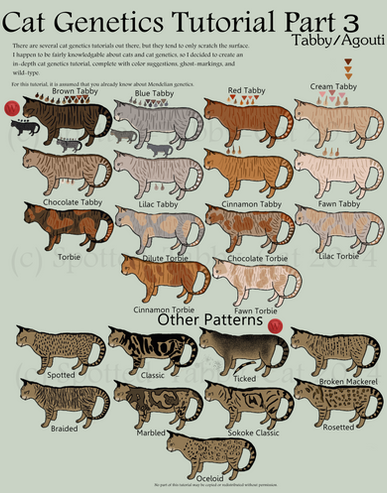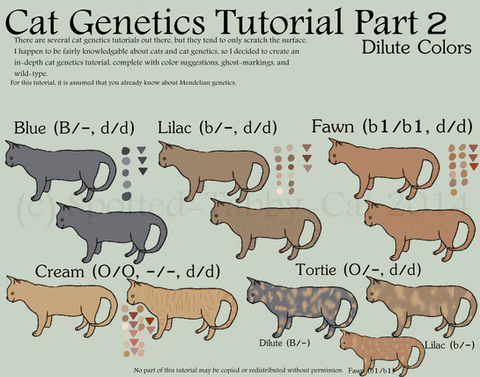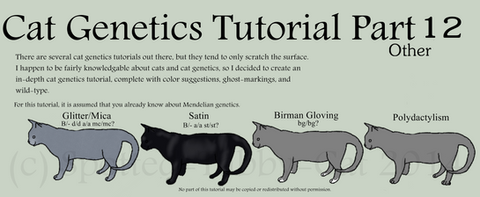HOME | DD
 Spotted-Tabby-Cat — Cat Genetics Tutorial Part 1.5 (Torties)
Spotted-Tabby-Cat — Cat Genetics Tutorial Part 1.5 (Torties)

Published: 2014-11-23 15:20:35 +0000 UTC; Views: 21528; Favourites: 200; Downloads: 180
Redirect to original
Description
This tutorial is out of date. Please see more information here .
There are multiple cat genetics tutorials about, but they tend to only cover the basics (base colors, dilutions, tabby, white-spotting, pointism, & tortie/orange). In-depth cat genetics tutorials tend to be lacking. So thus, this. I have no idea how long this will take to be completed. Hopefully before 2016.
In part 1 we learned about the B locus and the red gene. In this picture we get to see tortie acting on all the black variations. There really isn't much to say other than it cause patches of red on the base color, or patches of the base on red if you prefer. Ghost-markings are not shown, but basically put patches of red on the ghost-marked base for what it would look like.
Key:
Colored Circle - Color variations/suggestions
Colored Triangles - Nose leather colors
Part 1 (Base Colors):
Cat Genetics Tutorial Part 1 (Base Colors)
Part 1.5 (Torties):
Cat Genetics Tutorial Part 1.5 (Torties)
Part 2 (Dilutions):
Cat Genetics Tutorial Part 2 (Dilutions)
Part 3 (Tabby):
Cat Genetics Tutorial Part 3 (Tabby/Agouti)
Part 4 (White-Spotting):
Cat Genetics Tutorial Part 4 (White)
Part 5 (Pointism & Albinism):
Cat Genetics Tutorial Part 5 (Pointism & Albinism)
Part 6 (Silver & Gold Series):
Cat Genetics Tutorial Part 6 (Silver & Gold Series)
Part 7 (Color Changes):
Cat Genetics Tutorial Part 7 (Color Changes)
Part 8 (Weirdos):
Cat Genetics Tutorial Part 8 (Weirdos)
Part 9 (Hair):
Cat Genetics Tutorial Part 9 (Hair)
Part 10 (Tail):
Cat Genetics Tutorial Part 10 (Tail)
Part 11 (Ears):
Cat Genetics Tutorial Part 11 (Ears)
Part 12 (Other):
Cat Genetics Tutorial Part 12 (Other)
Related content
Comments: 26

👍: 0 ⏩: 1

👍: 1 ⏩: 1

👍: 0 ⏩: 0

My sister had a male calico a few years ago. I notice you haven't gone down the tortoiseshell-plus-white rabbit hole. I hope you do, because they're awfully attractive.
👍: 0 ⏩: 1

That's pretty cool! I have not. I do hope to redo the series sometime in the future (probably the far future, alas), so I could include that then!
👍: 0 ⏩: 1

👍: 0 ⏩: 0

Male torties can be caused by two main causes: chimerism and Kinefelter's Syndrome. Chimera is cuased when two zygotes fuse in the womb, creating one cat. If one is red based, and the other black based, you can get a tortie. Kinefleter's Syndrome happens when a male cat inherits two X chromosomes, causing an XXY cat. With two X chromosomes, the opportunity for a tortie coloration opens up, but the resulting cat will be sterile. You can also argue that a somatic mutation causing black hairs on an otherwise red cat could also create a male tortie.
👍: 0 ⏩: 1

Ok, cool. I love cats and genetics is cool. Thanks for the info.
👍: 0 ⏩: 1

You're welcome! I'm sorry for the late reply though. I also have an affinity for cats and genetics.
👍: 0 ⏩: 1

If a blue tabby (sire) and a white cat (dam), what would be the result of the kittens? I know that tabby is a dominant gene, as is white, would each kitten be a blue tabby with a splash of white? E.g. white paws?
👍: 0 ⏩: 1

It would depend on the exact genes. Whether or not each cat is homozygous or heterozygous and whether the dam is dominant white or extreme white-spotting are the main deciding factors. If the sire is homozygous for agouti (AA) all the kittens will be tabbies of some sort or another. If not, depending on the mother's genetics, some may be solid as well. If the mom is solid, and the sire is heterozygous, there is a 50% chance of tabby kittens. If both parents are heterozygous, there is a 25% chance of tabby kittens. If either are homozygous tabbies, than no kittens will be solid and all will be tabbies. For whether the kittens would be diluted or not, it depends on the dam. The sire is diluted, so he has to be homozygous recessive for the dilute gene (dd). The dam could be DD, Dd, or dd. If she is DD, none of the kittens will be diluted. If Dd, 50% will be, and if dd, all of them will be dilutes. As for the white, it depends on whether the white is dominant white (In which case the dam is wither WW or Ww, all white kittens in the former and 50% white kittens in the latter) or white-spotting. If it's white-spotting, the dam could again either by heterozygous or homozygous (WsWs or Wsws). If it is the former, all the kittens will express white-spotting to some degree, although given the dam's more extreme expression they'll probably be rather white. If the latter, 50% of the kittens will have white-spotting, again more likely to a more extreme degree. I hope I've helped, and if not feel free to ask for clarification.
👍: 0 ⏩: 0

What happens if a black cat and a red cat have kittens, and one is a tom? Will the tom be black or red, or could it be either?
👍: 0 ⏩: 1

That would depend on whether the mother is black or red. In the case of the red gene, only the X chromosome matters, so male cats only get one copy of the X chromosome. In order to be male, a cat has to inherit a Y chromosome from the father, meaning that the X chromosome comes from the mother. Hence, if the mother is black, all male kittens will be black, and if the mother is red, all male kittens will be red.
👍: 0 ⏩: 1

You know, I just found this and I think this going to be really helpful with people learning genetics and if someone wants to make extremely advanced adoptables too. I just needed to point this out, male cats can be tortoiseshell. They just happen to be sterile.
👍: 0 ⏩: 1

I hope it does help those who want to learn about cat genetics. True, male cats can be tortoiseshell, but it is extremely rare. Surprisingly, they aren't always sterile. Chimera cats (which will be covered in a later section, Wierdos) can be male tortoiseshells that are fertile, but they will only pass on one of the two colors.
👍: 0 ⏩: 1

I only know because I had a male tortoiseshell, he was sterile. I've seen Chimeras, such amazing cats. Never knew that male Chimera's could breed, it really is an interesting topic.
👍: 0 ⏩: 0

Oh I forgot. The genotypes you put above I haven't exactly learned how to use those yet lol
👍: 0 ⏩: 0

So,I have a Tortioseshell cat. She is now pregnant.
(We do plan to get her spayed after this litter)
It's her first litter. She matches the first Tortie shown above. And we are pretty sure the tom she mated with is a black and white piebald. However,I rescued my cat and it's the first time I have seen the black and white tom so I have no clue what their parents look like. Is there a way I can make a Punnett square to kind of guess why her kits may look like? I've been doing a ton of research and so far I found your charts to be most helpful so I was thinking maybe you'd have a better clue than I do. Thank you
👍: 0 ⏩: 1

First of all, thank you. Assuming that the cats don't carry any recessive genes, you could get female tortoiseshells, male or female blacks, or male reds. It is possible that the parents carry dilution, which would add blue males and females, dilute females, and cream males. The base color Punnett square would probably look something like:
| Black X | Red X
Black X | Black female | Tortie female
Blank Y | Black male | Red male
All the X chromosomes shown in the above Punnett square could carry chocolate or cinnamon, but that is highly unlikely. Please tell me if anything is unclear and I'll attempt to make it more clear.
👍: 0 ⏩: 1

Thank you so much for the help!!! I really appreciate it,it helps me a lot on predicted the colors
👍: 0 ⏩: 1

You're welcome. I'm glad that I could help.
👍: 0 ⏩: 1

Turned out we had five kittens 
👍: 0 ⏩: 0


























